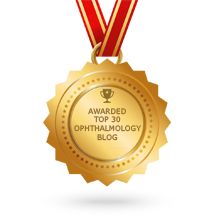
Pathognomonic Features in Ophthalmology
Here is the list of some important pathognomonic features of ophthalmic diseases.
- pathognomonic skin rash of Lyme disease.: erythema migrans
- pathognomonic of leprosy: Prominently visible beaded corneal nerves
- pathognomonic of GCA: jaw claudication
- Fuchs’ Heterochromic Iridocyclitis: keratic precipitates are small, round or stellate, and discrete; more significantly, they are distributed over the entire corneal endothelial surface and fine filaments are often seen between them. Their presence and extent is out of proportion to the inflammation.
- A heliotrope rash of the eyelids, although rare, is almost pathognomonic for dermatomyositis.
- AMD: fluorescein angiography results are virtually pathognomonic, revealing early hypofluorescence secondary to blockage from tl1e hemorrhage, often fol lowed by late hyperfluorescence in the distribution of the choroidal neovascular membrane.
- The ash-leaf spot, a leaf-shaped a rea of skin depigmentation that fluoresces under a Wood lamp, is considered pathognomonic for tuberous sclerosis.
- The ocular findings of cystinosis are pathognomonic. Iridescent elongated corneal crystals appear at approximately age 1 year, first in the peripheral part of the cornea and the anterior part of the stroma. These crystals are also present in the uvea and can be seen with the slit lamp on the surface of the iris. Severe photophobia can make a slit-lamp examination almost impossible without anesthesia.
- In lymphatic malformation, MRI may demonstrate pathognomonic features ( multiple grapelike cystic lesions wit h fluid-fluid la yering of the serum and red blood cells), confirming the diagnosis
- In cornea plana, Corneal curvature that is the same as that of the adjacent sclera is pathognomonic.
- Thiel-Behnke corneal dystrophy (TBCD), Bowman layer is replaced by fi brocellular material in a pathognomonic wavy "saw-toothed" pattern.
- MEWDS patients also develop an unusual transient foveal granularity that is nearly pathognomic of this condition and consists of tiny yellow-orange dots at the level of the RPE.
- A unilateral decrease in visual acuity is the most common symptom of toxoplasmosis. A unifocal area of acute-onset inflammation adjacent to an old chorioretinal scar is virtually pathognomonic for toxoplasmic chorioretinitis.
- Avulsion of the vitreous base may be associated with dialysis and is considered pathognomonic of ocular contusion.
- Crater-like retinal folds (arrowhead) in the macular region are virtually pathognomonic of shaken baby syndrome and are often associated with sub-internal limiting membrane (ILM) hemorrhages.
- In established trachoma, there may also be superior epithelial keratitis, subepithelial keratitis, pannus, or superior limbal follicles, and ultimately the pathognomonic cicatricial remains of these follicles, known as Herbert's pits—small depressions in the connective tissue at the limbocorneal junction covered by epithelium.
- Subretinal tracks (trails of depigmentation in the retinal pigment epithelium) are the result of maggot migration in the subretinal spaces and are pathognomonic of internal ophthalmomyiasis.
- The most important ocular manifestation is unilateral palpebral edema which is a pathognomonic feature of Chagas’ disease.
- Lattice dystrophy is an autosomal dominant condition characterized by pathognomonic branching ‘pipestem’ lattice figures within the stroma
- Posterior polymorphous dystrophy. Pathognomonic specular microscopy patterns occurring in the same patient range. From mild polymegathism and pleomorphism (top left) to discrete geographic areas (arrows) with minimal residual normal-appearing endothelial cell
- The large cobblestones of the upper tarsal plate are pathognomonic for VKC.
- In Acanthamoeba keratitis, Corneal findings usually begin with a ground-glass epitheliitis followed by stromal invasion signified by pathognomonic radial neuritis.
- Pars plana exudates (snowbanks) in the anterior vitreous overlying the peripheral retina and pars plana is considered pathognomonic of pars planitis.
- Uveitis of acquired syphilis can involve the anterior (50%) or posterior (50%) segment. The anterior segment inflammation is usually acute and nonspecific. In secondary disease, there may be associated pink iris nodules representing areas of localized neovascularization. These nodules are rare but are believed to be pathognomonic for ocular syphilis.
- Tumor involvement of the retina-sub–RPE is a pathognomonic feature of PIOL.
- the dark choroid (blockage of the choroidal fluorescence on fluorescein angiogram), pathognomonic of autosomal recessive Stargardt's, is absent in the autosomal dominant form.
- compiled & published by Dr Dhaval Patel MD AIIMS
